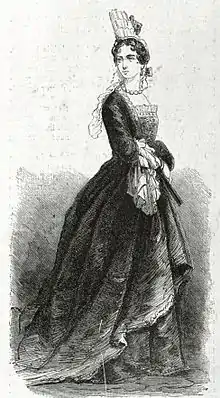François-Timoléon de Choisy
François Timoléon, abbé de Choisy (French: [ʃwazi]; 2 October 1644 – 2 October 1724) was a French cross-dresser, abbé, and author.[1]

Biography
De Choisy was born in Paris. His father was attached to the household of the duke of Orléans, whilst his mother, who was on intimate terms with Anne of Austria, was regularly called upon to amuse Louis XIV. By a whim of his mother, the boy was dressed like a girl until he was eighteen, and, after appearing for a short time in man's costume, he resumed woman's dress on the advice—perhaps satirical or tongue-in-cheek advice—of Madame de La Fayette. De Choisy delighted in the most extravagant toilettes until being publicly rebuked by the duc de Montausier, causing his retirement for some time to the provinces, thereupon, he allegedly used female appearance to serve numerous intrigues.
De Choisy was made an abbé in his childhood, and poverty, induced by extravagance, drove him to live on his benefice at Sainte-Seine in Burgundy, where a kindred spirit was found amongst his neighbours. in Bussy-Rabutin. De Choisy visited Rome in the suite of the cardinal de Bouillon in 1676, and shortly afterwards a serious illness brought about a sudden and rather frivolous conversion to religion.
In 1685, he accompanied the Chevalier de Chaumont on a mission to Siam.[2]:62 He was ordained a priest, and received various ecclesiastical preferments, such as the priory of Saint-Benoît-du-Sault in 1689. He was admitted to the Académie française on 24 July 1687.[3]
Works
De Choisy wrote a number of historical and religious works, of which the most notable are the following:
- Quatre dialogues sur l'immortalité de l'âme ... (1684), written with the Abbé Dangeau and explaining their conversion.
- Histoire de l'Eglise (11 vols., 1703–1723)
De Choisy is remembered for his gossiping Mémoires (1737), which contain striking and accurate pictures of the time and remarkably exact portraits of his contemporaries, although there is otherwise small pretension to historical accuracy.
The Mémoires passed through many editions, and were edited in 1868 by M. de Lescure. Some admirable letters of de Choisy are included in the correspondence of Bussy-Rabutin. De Choisy is said to have burnt some of their indiscreet revelations, but left a considerable quantity of unpublished manuscripts. Part of this material was surreptitiously used in an anonymous Histoire de madame la comtesse de Barres (Antwerp, 1735) and again with much editing in the Vie de M. l'abbé de Choisy (Lausanne and Geneva, 1742), ascribed by Paul Lacroix to Lenglet Dufresnoy; the text was finally edited (1870) by Lacroix as Aventures de l'abbé de Choisy. See also Sainte-Beuve, Causeries du lundi, vol. iii.
Influences
David Hume had de Choisy's Mémoires and their account of Siam in his library.[1]
References
- Alison Gopnik. "How David Hume Helped Me Solve My Midlife Crisis". The Atlantic.
- Chakrabongse, C., 1960, Lords of Life, London: Alvin Redman Limited
- "François-Timoléon de CHOISY". Académie française (in French).
 This article incorporates text from a publication now in the public domain: Chisholm, Hugh, ed. (1911). "Choisy, François Timoléon". Encyclopædia Britannica. 6 (11th ed.). Cambridge University Press. p. 262.
This article incorporates text from a publication now in the public domain: Chisholm, Hugh, ed. (1911). "Choisy, François Timoléon". Encyclopædia Britannica. 6 (11th ed.). Cambridge University Press. p. 262.